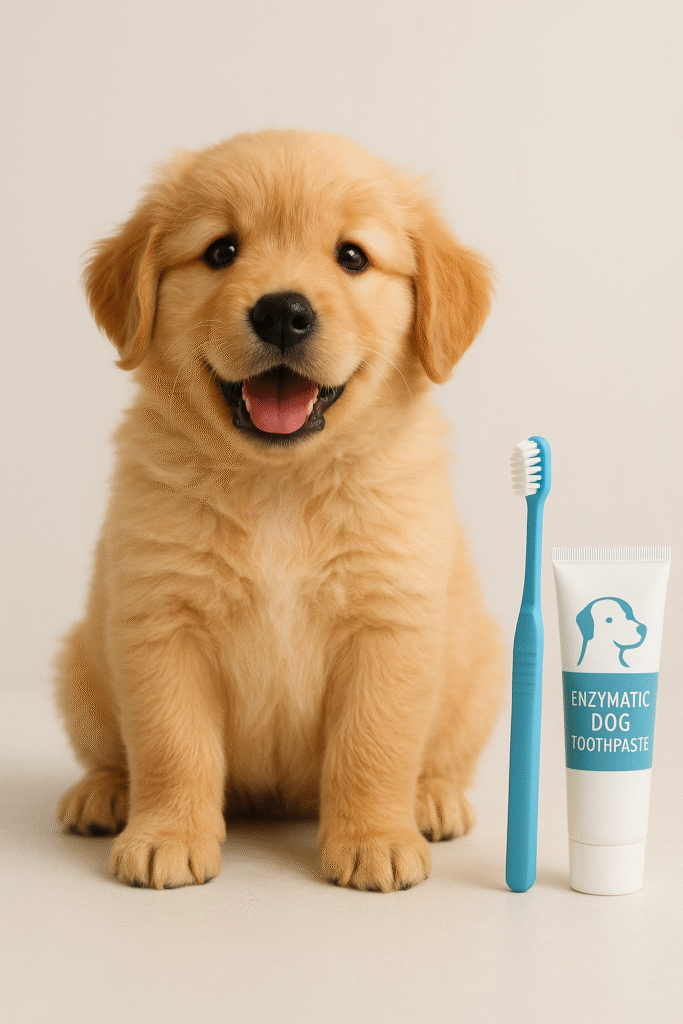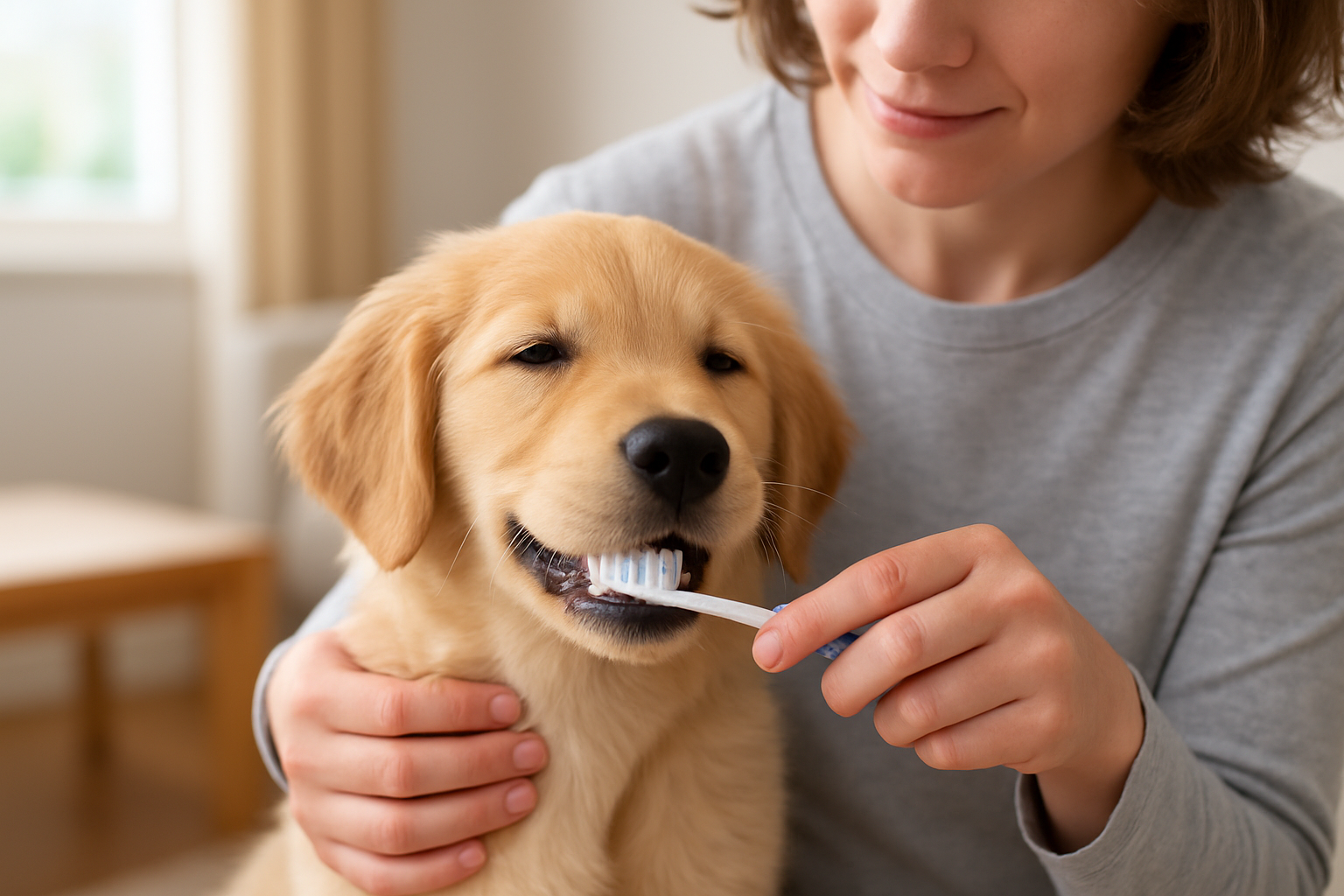That puppy breath—sweet, milky, and utterly irresistible! But as your furry bundle of joy grows, that adorable breath can quickly turn into something less pleasant. What many pet parents don’t realize is that dental health is a critical pillar of a puppy’s overall well-being, and it starts much earlier than you might think.
By the age of three, over 80% of dogs show signs of periodontal disease, which begins as simple plaque buildup. The good news? This is almost entirely preventable with proper care. And the very best tool in your arsenal is brushing puppy teeth.
It might sound daunting, but starting early and doing it right transforms it from a chore into a simple, bonding experience. This comprehensive guide, infused with expert veterinary advice, will walk you through exactly when to start, what you need, and how to make brushing puppy teeth a positive, stress-free part of your routine. Let’s set your pup up for a lifetime of healthy smiles! 😁
Why Brushing Your Puppy’s Teeth is Non-Negotiable 🦷
It’s easy to dismiss puppy dental care. After all, those sharp little baby teeth (deciduous teeth) are just going to fall out anyway, right? While that’s true, the habits and health foundations you establish now have lifelong repercussions.
- Prevents Painful Periodontal Disease: Plaque—a sticky film of bacteria—builds up within hours after eating. If not removed, it hardens into tartar (calculus) within days. Tartar irritates the gums, leading to inflammation (gingivitis) and eventually periodontal disease, which destroys the bone and ligaments supporting the teeth. This is incredibly painful for your dog.
- Protects Overall Health: The bacteria from periodontal disease don’t stay in the mouth. They can enter the bloodstream and travel to major organs, potentially causing serious issues in the heart, liver, and kidneys.
- Saves You Money: Professional veterinary dental cleanings require anesthesia and can cost hundreds, even thousands, of dollars for advanced disease. Consistent brushing puppy teeth at home is the most effective way to minimize the need for these procedures.
- Establishes Lifelong Good Habits: Getting your puppy comfortable with having their mouth handled makes every future vet visit, medication administration, and dental check-up easier and less stressful for everyone involved.
When to Start Brushing Your Puppy’s Teeth ⏰
The golden rule is: Start the very day you bring your puppy home.
Okay, maybe not with a toothbrush on the first night, but you should begin the process immediately. The ideal window for socialization and habit formation is between 8 and 16 weeks of age. During this period, puppies are most receptive to new experiences.
Here’s a phased timeline to follow:
- Weeks 8-12: Focus solely on acclimation and positive association. Your goal is not clean teeth, but a puppy who thinks having their mouth touched is a wonderful thing.
- Week 12+: Once your puppy is comfortable, you can introduce the actual tools and begin gentle brushing as their adult teeth start to erupt (around 12-16 weeks).
- Adult Teeth: By 6-7 months, all 42 adult teeth should be in. By this point, your goal is to have a established, routine habit of brushing puppy teeth daily.
A Note on Teething 🦴
Your puppy will start losing their baby teeth around 12-16 weeks. Their gums will be sore and sensitive during this time. Be extra gentle! This is not the time to force the issue. If your puppy seems uncomfortable, take a step back and just offer a soft gum massage or take a break for a day or two.
What You’ll Need: The Puppy Dental Toolkit 🧰
Using the right tools is half the battle. Never, ever use human toothpaste. It contains fluoride and often xylitol, which are toxic to dogs.
- Dog Toothpaste: This is the secret weapon. Dog toothpaste is formulated to be safe for swallowing and comes in delicious flavors like poultry, beef, and peanut butter. The enzymes in these toothpastes help break down plaque. Let your puppy lick it off your finger first—they’ll see it as a treat!
- Toothbrush: You have a few options:
- Finger Brush: A small, soft silicone brush that fits over your fingertip. Excellent for beginners and small puppies as it gives you great control and feels less intimidating to the pup.
- Dual-Ended Dog Toothbrush: These have a larger head on one end for big teeth and a smaller head on the other for precise cleaning. The bristles are softer than human brushes.
- Soft-Bristled Children’s Toothbrush: In a pinch, a very soft brush designed for human toddlers can work.
- Gauze or a Dental Wipe: If your puppy is terrified of the brush, you can start by wrapping your finger in gauze, adding toothpaste, and gently rubbing the teeth. It’s less effective than a brush but far better than nothing.
- High-Value Treats: Have your puppy’s absolute favorite treats on hand to reward calm behavior after each step.
Actionable Tip: The Taste Test
Before you even touch your puppy’s mouth, introduce the toothpaste. Offer a small dab on your finger and let them lick it off. Do this for a few days until they get excited when they see the tube. You’re building a positive association!
How to Brush Your Puppy’s Teeth: A Step-by-Step Guide 📋
Patience and positivity are everything. Keep sessions short (30-60 seconds max to start) and always end on a positive note.
Step 1: Get Them Comfortable
Choose a time when your puppy is calm and tired, like after playtime. Get down on their level and give them some gentle pets.
Step 2: Introduce the Mouth Touch
Lift their lip gently with one hand. With the other, quickly touch their teeth and gums and then immediately give a treat and praise. Repeat this, slowly increasing the time your finger is in their mouth.
Step 3: Add the Taste
Put a small amount of toothpaste on your finger and let them lick it. Then, repeat Step 2, but now with the tasty toothpaste on your finger, rubbing it lightly on their canine teeth (the long fangs), which are easiest to reach.
Step 4: Introduce the Brush
Let your puppy sniff and investigate the toothbrush. Put toothpaste on it and let them lick it off. Show them it’s a source of good things.
Step 5: The First Brush
Gently lift their lip. Using the brush, make small, gentle circular motions, focusing on the outside surfaces of the teeth—especially where the gum meets the tooth. The tongue does a fairly good job of keeping the inside surfaces clean. Don’t worry about being perfect. Focus on the big canine and cheek teeth (premolars and molars).
Step 6: Praise and Reward!
After just a few seconds of brushing, stop, give effusive praise, and a high-value treat. This teaches them that tolerating the brushing leads to amazing things.
Troubleshooting Common Problems 🚧
- My Puppy Won’t Sit Still: Keep sessions incredibly short. 5 seconds of brushing is a win! Pair it with a “sit” or “stay” command they already know.
- My Puppy Bites the Brush: This is normal puppy exploration. Use a finger brush for more control, or try a different-textured brush. Redirect the behavior gently.
- My Puppy Absolutely Hates It: Go back a step. If they hate the brush, go back to your finger. If they hate your finger, just focus on lifting their lip and giving a treat. The goal is to avoid creating a negative association. For extreme cases, talk to your vet about dental gels or water additives that can help alongside your efforts.
Beyond Brushing: Supporting Your Puppy’s Dental Health 🦴
While brushing is the best method, a multi-faceted approach is even better.
- Dental Chews & Toys: Look for products approved by the Veterinary Oral Health Council (VOHC). These are scientifically proven to reduce plaque and tartar. Rubber toys with grooves (like Kongs) can help clean teeth as they chew.
- Diet: Some kibbles are specifically formulated with dental health in mind, with a texture designed to scrub the teeth as the dog chews.
- Regular Vet Check-ups: Your veterinarian will check your puppy’s mouth at every appointment, monitoring for retained baby teeth, bite alignment issues, and signs of disease. They are your best partner in this journey.
Final Woof: Patience Creates a Lifetime of Health 🐾
Starting the habit of brushing puppy teeth is one of the most impactful things you can do for your dog’s long-term health and comfort. It’s not about achieving a perfect scrub on day one. It’s about building trust, creating positive associations, and making it a normal part of life.
Be patient with your puppy and with yourself. Some days will be better than others. Celebrate the small victories—a few more seconds of brushing, less squirming, a happy tail wag during the process. You’re not just cleaning teeth; you’re investing in countless healthy, happy years with your best friend.

Ready to Boost Your Puppy’s Dental Routine? While brushing is essential, the right dental chews can provide a helpful boost in fighting plaque and keeping breath fresh. For reviews of products that are effective, digestible, and perfectly sized for puppy mouths, read our buyer’s guide: Best Dental Chews for Puppies.






